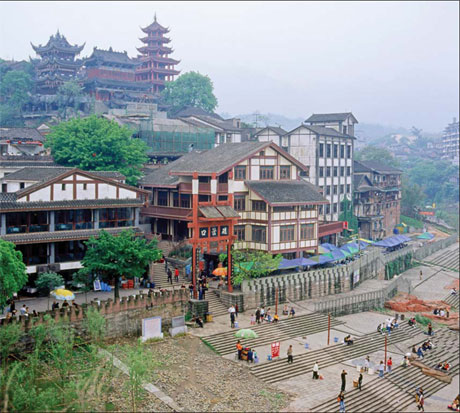Chongqing express
Updated: 2012-04-13 07:43
(China Daily)
|
|||||||||||
|
Locals of Ciqikou are still devoted to their traditional lifestyles. [Provided to China Daily] |
Southwest giant packs a punch for business and leisure
As the country's largest municipality, Chongqing, in Southwest China, boasts an attractive mix of history and modernity. Perched beside the Yangtze River, the 3,000-year-old city represents the Yangtze River civilization and is the birthplace of Bayu culture.
Surrounded by mountains and by the Yangtze and Jialing rivers on three sides, Chongqing is also called Mountain City.
Chongqing's streets are famously undulating and built on slopes. At night, the lights of homes dot the hills, sparkling like stars. Bridges light up in the evenings as ships beneath them glide along the two rivers.
As the major manufacturing center and a transport hub for western China, Chongqing serves as the economic center of the upper reaches of the Yangtze River, and attracts visitors from home and abroad for its famous spicy dishes, cultural heritage and stunning modern scenery.
1. Dazu Rock Carvings
 |
Located 167 kilometers east of Chongqing, Dazu county is known as the county of rock carvings.
Started around 650 during the Tang Dynasty (618-907) and continued through the Ming (1368-1644) and Qing (1644-1911) dynasties, the Dazu Rock Carvings contain all the cliff-side carvings in Dazu county and demonstrate the peak of ancient artisans' skills in the area.
The collection is composed of rock carvings in Beishan, Baodingshan, Nanshan, Shimenshan and Shizhuanshan. There are more than 5,000 statues and 100,000 Chinese characters of inscriptions and epigraphs among the rock carvings, with Buddhist, Taoist and Confucian figures showcasing the artistic achievements of the area and its people.
2. Ciqikou
On the banks of the Jialing River, not far from its junction with the Yangtze River, lies the ancient village of Ciqikou (porcelain village). Covering an area of about 1.2 square kilometers, it is 14 kilometers west of Chongqing.
Ciqikou can be traced back more than 1,000 years. It gets its name from the classic porcelain handicrafts made in the village.
Formerly a busy port at the lower reaches of the Jialing River, Ciqikou remains a symbol and miniature of old Chongqing. In 1998 the State Council listed Ciqikou as a protected cultural site.
Tourists will find that the locals are still devoted to their traditional lifestyles and unaffected by the trappings of modernity in the city. A major attraction is the Shu Embroidery workshops.
3. People's Assembly Hall
As one of the largest public assembly buildings in China, the People's Assembly Hall in Chongqing is one of the landmark buildings in the city.
Standing at Xuetian Wan, Renmin Road, the auditorium is built in the traditional Chinese style.
The main complex is a cluster of attached structures, which contain the hall and three attached buildings to the east, south and north. It is spanned by a greenish-glazed tile dome, supported by scarlet columns. The building's pillars and other structural elements are sculpted in a delicate and refined way, all framed amid lush greenery.
4. Eating and drinking
As one branch of Sichuan cuisine, Chongqing cuisine, also called Yu cuisine, is famous for its distinctively spicy and strong flavors.
The city has a humid, cloudy climate with an annual mean temperature of 18.6 C, leading the locals to become addicted to spicy dishes that they reckon are stronger in taste than their Sichuan neighbors' offerings.
Chili pepper, sesame, scallions, ginger, garlic, wine, soy sauce and seasoning are employed in almost 40 different cooking methods, including drying, salting, spicing, frying and smoking. Smell, taste, presentation and nutrition are all delicately coordinated in Chongqing dishes.
Many local specialties such as steamed sticky rice sparerib, taoran chili chicken with taro are popular with residents and visitors.
Chongqing is touted as the birthplace of hot pot in China and the restaurants can be found in virtually every corner of the city.
Hot pot used to be a winter dish but is now eaten all year round.
With the catering business thriving, many food streets are developing. The pedestrian streets around Jiefangbei (called Jiefangbei Central Business District), Nanbin Road, and Bayi Street are full of restaurants.
Many eateries also dot Nanbin Road by the bank of the Yangtze. Tourists can pick a riverside table to take in the night view of the river and the city as they wine and dine.
China Daily
Today's Top News
Rescuers race against time for quake victims
Telecom workers restore links
Coal mine blast kills 18 in Jilin
Intl scholarship puts China on the map
More bird flu patients discharged
Gold loses sheen, but still a safe bet
US 'turns blind eye to human rights'
Telecom workers restore links
Hot Topics
Lunar probe , China growth forecasts, Emission rules get tougher, China seen through 'colored lens', International board,
Editor's Picks

|

|

|

|

|

|






